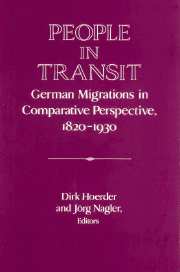Book contents
- Frontmatter
- Introduction
- PART I CONTINUITY AND COMPLEXITY: MIGRATIONS FROM EAST ELBIAN GERMANY AND GALICIAN POLAND
- 1 German Emigration Research, North, South, and East: Findings, Methods, and Open Questions
- 2 Colonist Traditions and Nineteenth-Century Emigration from East Elbian Prussia
- 3 Overseas Emigration from Mecklenburg-Strelitz: The Geographic and Social Contexts
- 4 Emigration from Regierungsbezirk Frankfurt/Oder, 1815-1893
- 5 Preserving or Transforming Role? Migrants and Polish Territories in the Era of Mass Migrations
- Part II Internal German Migrations and In-Migrations
- PART III WOMEN'S MIGRATION: LABOR AND MARRIAGE MARKETS
- PART IV ACCULTURATION IN AND RETURN FROM THE UNITED STATES
- 18 Migration Past and Present - The German Experience
- 19 Research on the German Migrations, 1820s to 1930s: A Report on the State of German Scholarship
- Index
3 - Overseas Emigration from Mecklenburg-Strelitz: The Geographic and Social Contexts
Published online by Cambridge University Press: 05 January 2013
- Frontmatter
- Introduction
- PART I CONTINUITY AND COMPLEXITY: MIGRATIONS FROM EAST ELBIAN GERMANY AND GALICIAN POLAND
- 1 German Emigration Research, North, South, and East: Findings, Methods, and Open Questions
- 2 Colonist Traditions and Nineteenth-Century Emigration from East Elbian Prussia
- 3 Overseas Emigration from Mecklenburg-Strelitz: The Geographic and Social Contexts
- 4 Emigration from Regierungsbezirk Frankfurt/Oder, 1815-1893
- 5 Preserving or Transforming Role? Migrants and Polish Territories in the Era of Mass Migrations
- Part II Internal German Migrations and In-Migrations
- PART III WOMEN'S MIGRATION: LABOR AND MARRIAGE MARKETS
- PART IV ACCULTURATION IN AND RETURN FROM THE UNITED STATES
- 18 Migration Past and Present - The German Experience
- 19 Research on the German Migrations, 1820s to 1930s: A Report on the State of German Scholarship
- Index
Summary
In the second half of the nineteenth century, the Grand Duchy of Mecklenburg-Strelitz was one of those northeast German regions from which emigration to North America was especially intensive and massive (see Map 3.1). Emigration to America from this region started in 1846-47; that is, it should be noted, before the revolution of 1848 in Germany. The core areas of early emigration were located on the border to the Uckermark (Brandenburg). This fact points to the initiating and stimulating role of information from this area that subsequently directed emigration to North America. Even before this emigration began, Mecklenburg-Strelitz experienced a sharp decline in population due to migrations principally to Prussia and, increasingly, especially to Berlin. Within this context, migration patterns can be identified on the village level as well and extrapolated to the larger entities examined in this essay: the duchy, state-owned areas (Domanium), local administrative units of the state-owned areas (Domanialämter), and groups of villages. Although neither substantive factors of a more complex structural and causal analysis nor the problems of chain migrations can be dealt with here, this essay will examine the emigration patterns of various groups of agricultural laborers, paying particular attention to their geographical differences and social conditions.
SCOPE, COURSE, AND STRUCTURE OF EMIGRATION
The Duchy of Mecklenburg-Strelitz, which in 1871 had a population of 79,976, encompassed an area of 2,547 square kilometers. This does not include the Principality of Ratzeburg, which was also part of the Grand Duchy. To the west, the duchy was bordered by Mecklenburg-Schwerin, to the east and south by Brandenburg, and to the north by Pomerania. Between 1846 and 1914, 15,953 persons in possession of either an emigration permit or a passport emigrated from the duchy to overseas destinations. North America was the destination that the overwhelming majority of these migrants (96.5 percent) set for themselves (see Table 3.1). Overseas emigration from the area reached its peak in 1872, when 1,275 people left, that is, 1.57 percent of the total population.
- Type
- Chapter
- Information
- People in TransitGerman Migrations in Comparative Perspective, 1820–1930, pp. 57 - 78Publisher: Cambridge University PressPrint publication year: 1995



